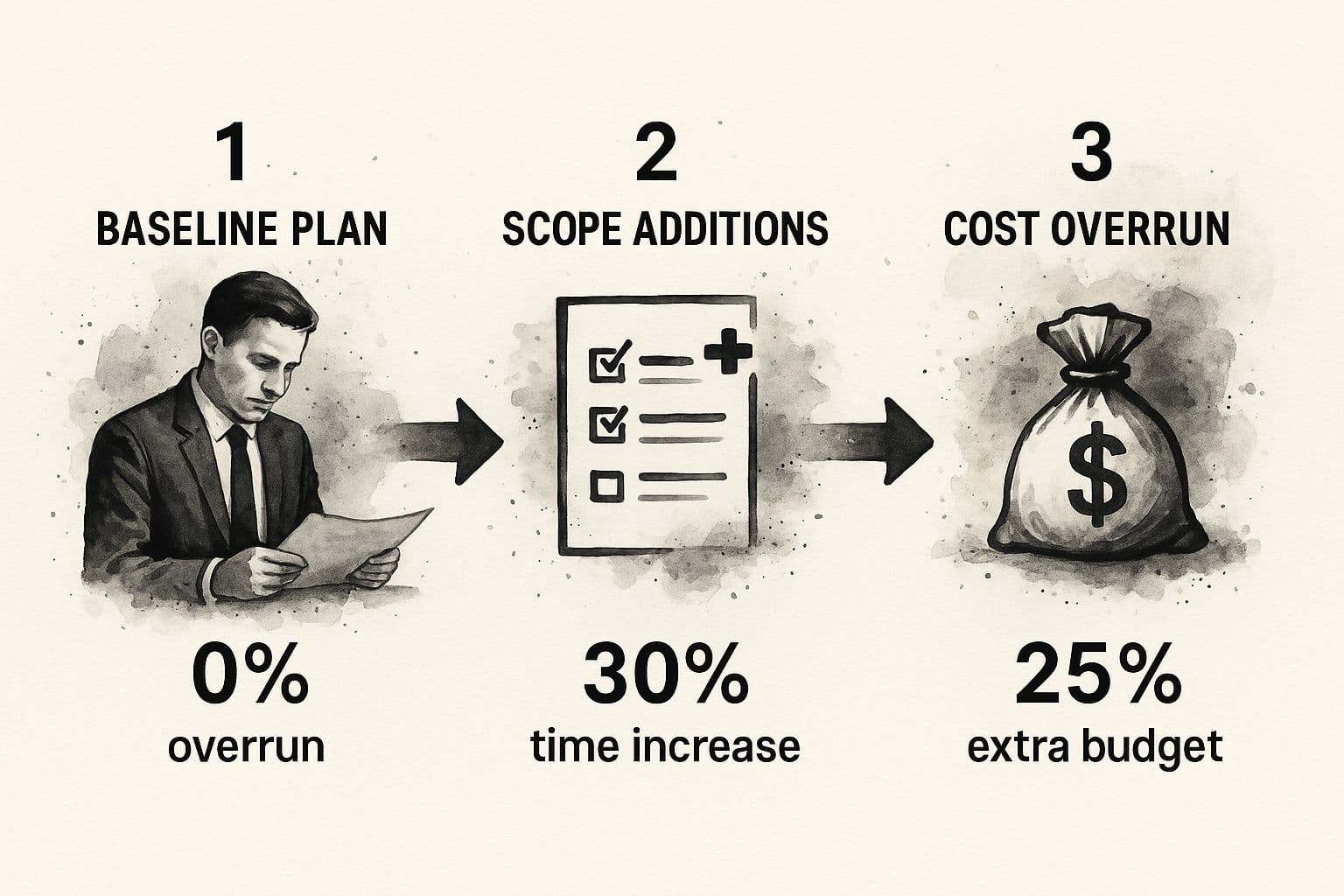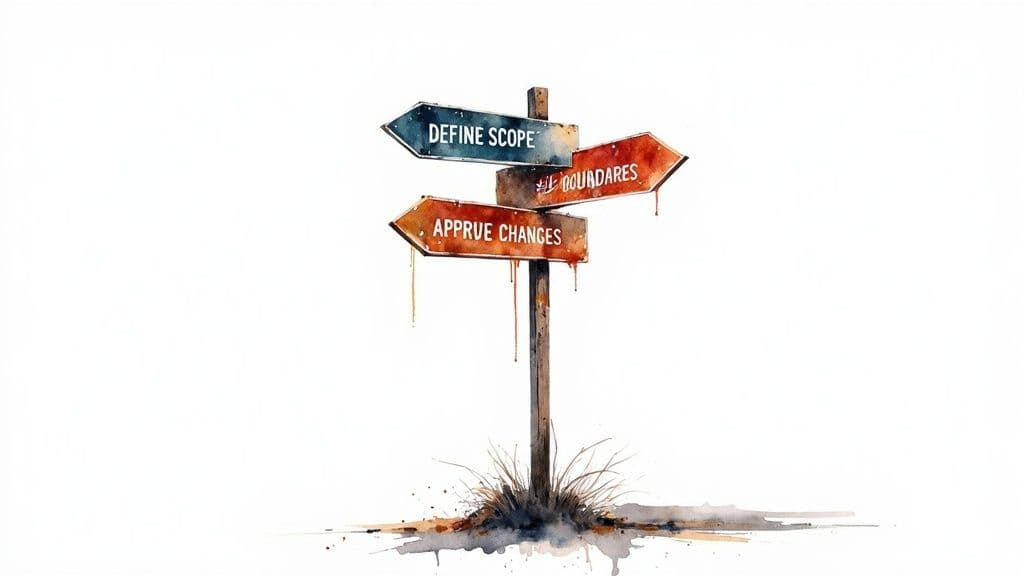Discover proven strategies for managing project scope creep. Learn how to keep your projects on budget, on time, and aligned with stakeholder expectations.
July 12, 2025 (5mo ago)
Managing Project Scope Creep Like a Pro
Discover proven strategies for managing project scope creep. Learn how to keep your projects on budget, on time, and aligned with stakeholder expectations.
← Back to blog
Managing project scope creep is one of those skills that separates seasoned project managers from the rest. It’s all about drawing a clear line in the sand—defining exactly what is and isn't part of the project—and then holding that line. This isn't about being rigid; it’s about having a solid project foundation, a clear process for handling changes, and fantastic communication with everyone involved.
The Hidden Costs of Uncontrolled Changes
We’ve all heard the term "scope creep," but it’s more than just a bit of project management jargon. It’s a silent killer of projects. It starts small, with a few seemingly harmless "yeses" to new ideas or requests. Before you know it, those little additions have snowballed, chewing through your budget and pushing your deadlines further and further out. A minor tweak here, a small feature there—it all adds up.

And this isn't just a hunch; it's a massive, industry-wide problem. The data is pretty stark. A recent study found that an incredible 52% of all projects** experienced scope creep in a single year. That’s a sharp jump from just 43% five years ago, showing that keeping projects on track is getting harder.
The financial fallout can be devastating. Take the Royal Adelaide Hospital project, which spiraled into an AU$640 million budget overrun, much of it blamed on expanding scope. You can read the full details in this eye-opening PMI report on rising scope creep.
Recognizing the Early Warning Signs
The real trick to fighting scope creep is catching it early. It almost never shows up as one big, obvious request. Instead, it’s a slow burn of small adjustments and additions that, individually, seem perfectly reasonable.
To help you spot these issues before they take root, this table breaks down the most common drivers of scope creep and what you’ll see happen almost immediately.
Common Causes and Initial Impacts of Scope Creep
| Cause of Scope Creep | Immediate Project Impact |
|---|---|
| Vague Initial Requirements | The project team makes assumptions, leading to rework when "clarifications" (which are actually new features) emerge later. |
| Informal Change Requests | Work gets done without proper assessment of its impact on the timeline, budget, or other tasks. Chaos ensues. |
| Disengaged Stakeholders | Key decision-makers appear late in the game with new demands that conflict with the original, agreed-upon plan. |
| Lack of a Formal Change Control Process | "Sure, we can do that" becomes the default response, with no system to track, approve, or reject new ideas formally. |
| "Gold Plating" by the Team | Well-meaning team members add extra features they think are cool or helpful, but that the client never asked for or budgeted for. |
| Inadequate Risk Management | Unforeseen issues pop up, and the knee-jerk reaction is to expand the scope to solve them, rather than sticking to the plan. |
Keeping an eye out for these causes is your first line of defense. When you see them happening, you know it's time to act decisively.
The problem isn't change itself. Change can be good. The real enemy is unmanaged change. A project without a clear framework to evaluate and approve new requests is a project that's practically guaranteed to go off the rails.
Getting a handle on this is the first real step. Mastering scope creep is what separates projects that deliver real value from those that become cautionary tales of missed deadlines and burned-out teams. It’s how you protect your team, maintain trust with your stakeholders, and make sure the final result actually matches the goals you set out to achieve.
Building a Bulletproof Project Foundation
Your strongest defense against scope creep isn’t some fancy, complicated change control system. It's the rock-solid foundation you lay before a single line of code is written or a single design element is created. I’ve seen it time and again: a rushed start almost guarantees you'll be fighting an uphill battle against unexpected changes and moving goalposts.
It all begins with digging deeper than a simple project brief. You need to sit down and have real conversations with your stakeholders. This isn't just a box-ticking exercise to ask what they want. You have to play detective, uncovering their hidden assumptions and unstated expectations. Ask the tough, probing questions to get past the "what" and really understand the "why" behind every single request. Getting that clarity upfront nips future misunderstandings in the bud.
Crafting Your Core Documents
Once you have that deep understanding, it's time to get it all down on paper. This means creating two absolutely critical documents: the scope statement and the Work Breakdown Structure (WBS).
Think of the scope statement as your project’s constitution. It needs to be crystal clear about the project’s boundaries. List exactly what is included and—this is just as important—what is explicitly excluded. The more precise you are here, the less room there is for "I thought that was included" conversations later.
From there, the Work Breakdown Structure takes that scope and smashes it into smaller, more manageable pieces. This creates a visual, hierarchical map of all the work that needs to get done. It’s how you make sure everyone, from the developer to the CEO, understands exactly what "done" looks like for every part of the project.
It's easy to dismiss small changes, but they add up. Scope creep is a huge reason projects fail, with some studies showing that 37% of project failures come from poorly defined goals and milestones. Those "quick additions" can easily snowball, draining your resources and blowing up the budget.
Creating a Single Source of Truth
With your scope statement and WBS locked in, the next step is to create a single source of truth. This is one central place where all the approved project documents live—no more hunting through email chains or Slack channels.
In a tool like Fluidwave, you can set up a dedicated project space for this. It becomes the official home for your scope, WBS, and any other key documents, easily accessible to the whole team and all your stakeholders.
This centralized hub does a few key things for you:
- Ensures Alignment: Everyone is literally on the same page, working from the same set of plans.
- Reduces Confusion: You kill the problem of someone working off an old, outdated version of a document.
- Provides a Reference: When a new request inevitably pops up, you can instantly point back to the agreed-upon scope.
Building this foundation often means leaning on proven, adaptive frameworks. For instance, a solid grasp of Agile principles can give you the structure you need while still allowing for flexibility. If you're new to it, this practical guide to Agile methodology is a fantastic starting point.
Putting in this work upfront isn't just a "nice-to-have"; it's non-negotiable if you want to keep scope creep in check. It’s what turns a fuzzy idea into a well-defined, shared plan of action. This is especially true for those juggling multiple clients or smaller gigs, a topic we cover in our guide on project management for freelancers. By taking the time to build this bulletproof foundation, you create a powerful shield that protects your project from the slow, quiet death of unmanaged change.
Designing a Practical Change Control Process
Let's be realistic—change happens. In any project worth doing, new ideas will pop up, and priorities might shift. The real test isn't whether you can prevent change, but how you manage it. The secret to taming scope creep isn't about saying "no" to everything; it's about evaluating new requests intelligently. A solid change control process is your best friend here, turning potential chaos into structured, well-informed decisions.
The aim isn't to wrap your project in red tape. A good process should be practical, not a bureaucratic nightmare that stifles creativity. It simply provides a clear path for anyone to submit a change request and for project leaders to assess its true impact on the project's big three: time, budget, and resources.
The Anatomy of a Simple Change Request
The centerpiece of this entire system is the change request form. Don't overcomplicate it. Its only job is to capture the essential details right away, forcing both the requester and your team to think through the ripple effects.
A truly effective change request form needs to answer a few key questions:
- A Clear Description: In simple terms, what is the proposed change?
- The "Why" Behind It: What problem is this solving, or what new opportunity does it unlock?
- Impact Analysis: What’s the initial guess on how this will affect the timeline, budget, and team workload?
- Priority Level: How important is this? Is it a "must-have" to meet the project goals, or a "nice-to-have" that could wait?
Just the act of filling this out changes the entire dynamic. It elevates the conversation from a casual "Hey, can we just add...?" to a structured evaluation of the actual trade-offs involved.
Take the construction industry, where a seemingly minor change can spiral into massive cost overruns. It's a world where an astonishing 85% of projects hit by scope creep go over budget. The average cost overrun directly tied to scope expansion is a painful 27%. A formal process provides that crucial pause needed to prevent those kinds of numbers. You can learn more about how the construction sector grapples with the financial impact of scope creep.
From Request to Resolution
So, what happens when a request is submitted? It enters a straightforward approval workflow. Let’s say a client wants a new reporting feature added right in the middle of a development sprint. Instead of a knee-jerk yes or no, you lean on your process.
First, the request is logged. Then, your team digs in to analyze the true impact. You figure out it will add 30 hours of development work and push the launch date back by a full week. With this data in hand, you go back to the stakeholders.
This is where the magic happens. You aren't just dropping a problem in their lap; you're presenting a decision. When you communicate the trade-offs clearly, you empower them to make a smart business call.
The choice is theirs: "We can absolutely build this new reporting feature. To do it, we'll need to extend the timeline by one week and adjust the budget by $X. The alternative is to add it to our backlog for a future phase. Which path best aligns with our strategic goals right now?"
This simple shift in communication turns you from a gatekeeper into a strategic partner. It protects the project's health while keeping your relationship with stakeholders strong. Every change becomes a deliberate choice, not an accidental budget-buster.
This chart shows just how quickly those "small" additions can snowball.

As the visual makes clear, what often begins as a simple scope addition can quickly escalate, putting serious pressure on both the project schedule and its bottom line.
Keeping Your Project on Track with Active Monitoring
Even the best-laid plans can go sideways once a project kicks off. This is where your focus shifts from careful planning to active, day-to-day vigilance. It’s not about breathing down your team’s neck, but about establishing a steady rhythm of oversight to catch small deviations before they mushroom into major problems.
Think of it this way: without regular check-ups, even a solid project foundation can start to show cracks.

This oversight needs to be baked right into your routine. Start with your regular status meetings. Don't just tick off completed tasks and upcoming to-dos. Make "scope review" a permanent, non-negotiable agenda item. This simple change creates a dedicated space to measure progress against the original plan and openly discuss any potential changes that have popped up.
Spotting the Early Warning Signs
Scope creep is sneaky. It rarely barges in announced; instead, it slips in through small, seemingly harmless requests and overlooked details. Your job is to be the lookout, scanning the horizon for these subtle red flags.
Keep an eye out for these tell-tale signs:
- Persistent Delays: When a task consistently blows past its estimate, it’s often a symptom of misunderstood complexity or, worse, unapproved requirements being tacked on.
- Off-the-Books Work: Finding team members working on tasks that aren't in the project plan? That’s a classic sign that stakeholders are making informal requests and bypassing your change process.
- Fuzzy Updates: If progress reports start feeling vague and lack concrete deliverables, your team might be wrestling with unclear or shifting requirements.
Catching these issues means going beyond a simple "How's it going?" You have to dig in. To really get a handle on what to measure, check out our guide on the most important project tracking metrics.
The Hidden Danger of Gold Plating
One of the most common—and frustrating—forms of scope creep comes from within your own team. It's called gold plating. This happens when someone, usually with the best intentions, adds extra features or polish that go beyond the agreed-upon requirements, simply because they think it will add value.
The intent might be good, but the outcome is pure scope creep. Gold plating eats up time and money that was never budgeted, putting the project's core deliverables at risk. I've seen it happen countless times—a developer spends an extra day on a slick animation the client never asked for, while a critical bug fix gets pushed to the back burner.
The best defense against gold plating is creating a culture where everyone respects the scope statement as the single source of truth. Remind your team that "done" means the requirements are met—nothing more, nothing less. Great new ideas should absolutely be encouraged, but they need to go through the formal change control process, not straight into the product.
This is where a good project management tool becomes your best friend. In a platform like Fluidwave, you can use a visual dashboard to get a real-time, at-a-glance view of progress against your plan. This immediate feedback loop lets you spot deviations the moment they happen, so you can step in and get the project back on track before a small detour turns into a costly derailment.
Mastering Stakeholder Communication and Negotiation
When it comes to scope creep, your best defense is often a good conversation. Even with an iron-clad project plan and a formal change process, everything can unravel during a single stakeholder discussion. Learning to navigate these tough conversations—and negotiate without burning bridges—is what separates seasoned project managers from the rest. It's a critical skill for keeping your project on track.

The trick is to stop being a gatekeeper. If your default response is just "no," you'll quickly be seen as an obstacle. Instead, your role is to be a strategic partner. Help stakeholders see the real impact of their requests. When you frame every chat around shared goals and the trade-offs needed to hit them, you turn a potential fight into a collaborative problem-solving session.
This is where a solid stakeholder communication plan becomes invaluable. It sets the rules of engagement from day one, so everyone knows how and when we'll talk about changes. No surprises.
Framing the Conversation for Success
The moment a stakeholder asks for something new, your response dictates everything that follows. A flat-out "no" is a conversation killer. A better approach is to educate. Walk them through the consequences so they can make an informed choice based on what they truly value.
Here are a few phrases I've used that work wonders. Feel free to make them your own:
- Acknowledge and Explore: "That’s a great idea. Let's dig into what it would take to build that. I want to make sure we both understand how it impacts our current timeline and budget."
- Present a Choice: "We can definitely add that feature. Our team estimates it will add two weeks to the schedule. Is that a trade-off you're comfortable with, or is sticking to the original launch date the top priority?"
- Suggest an Alternative: "To stay on track for our launch, what if we move this to the top of the list for Phase 2? We can get the core product out the door and then circle back to this immediately after."
This turns you into an ally. You aren’t the person saying no; you're the person presenting clear, logical options. If you need a structured way to formalize this, our project communications plan template can help you keep these crucial conversations consistent and documented.
The Art of the "Yes, and..."
Negotiating scope isn't about winning an argument. It’s about finding a path forward that works for everyone. You want to say "yes" to the person even if you have to say "not right now" to the request. It’s a small shift in mindset with a huge impact.
Remember, the person making the request often doesn't see the full picture of how their "small ask" affects the entire project ecosystem. Your job is to calmly and clearly illuminate the ripple effects on time, resources, and budget.
When you master these communication skills, you do more than just protect the project from chaos. You build incredible trust with your stakeholders. You show them you’re a leader who has their best interests—and the project’s—at heart.
In a tool like Fluidwave, you can take this a step further. Document these decisions and conversations right inside the relevant task. This creates a transparent audit trail, which is an absolute lifesaver when someone asks, "Wait, why didn't we add that feature again?" a few months down the line.
Answering Your Scope Creep Questions
Even with the best-laid plans, scope creep throws some tough questions our way. Let's dig into some of the most common situations project managers find themselves in when trying to keep a project on track. Getting these answers straight will help you handle these real-world challenges like a pro.
What Is the Difference Between Scope Creep and Gold Plating?
It's a subtle but critical distinction. Scope creep is what happens when uncontrolled changes sneak into a project, usually from external stakeholders, after the plan is set. It’s the classic "while you're at it, can you just add..." request from a client that wasn't part of the original deal.
Gold plating, on the other hand, is an inside job. It’s when your team adds extra features or polish that nobody asked for. They might think they're delighting the customer, but these well-intentioned additions can blow up your budget and schedule just as easily as scope creep.
The outcome is often the same—more work than was planned for—but knowing the source helps you address the root cause. Are you dealing with stakeholder expectations or team discipline? Each requires a different conversation.
How Can I Manage Scope Creep in an Agile Project?
This trips a lot of people up. Because Agile is designed to embrace change, some teams mistakenly think it’s a free-for-all. It absolutely is not.
In an Agile environment like Scrum, you manage scope through the product backlog. Yes, the backlog is a living document, but any changes are handled in a very structured way.
When a new idea comes up, it doesn't just get crammed into the current sprint. Here's how it's properly handled:
- The request is captured as a new user story and added to the product backlog.
- The Product Owner reviews, discusses, and prioritizes it against all other pending work.
- It's then considered for inclusion in a future sprint, not the current one.
This process respects the team's focus on the current sprint goal while still allowing the project to adapt over time. The key is making every potential change visible and forcing a conscious, strategic decision about its importance. That's the polar opposite of uncontrolled creep.
What Should I Do When a Critical Scope Change Is Necessary?
Sometimes, a change isn't just a "nice-to-have"—it's a game-changer that's essential for the project's success. When you're facing an unavoidable and critical change, you don't throw your process out the window. You lean on it.
This is exactly why you have a formal change control system.
First, document the request meticulously with a change request form. Then, do your homework: analyze the full impact this change will have on the budget, timeline, resources, and even other deliverables.
Present this complete analysis to your project sponsors and key stakeholders. The goal isn't to say "no," but to get a formal decision based on all the facts. This turns a potential crisis into a controlled, strategic pivot, complete with a newly approved and re-baselined project plan.
Ready to stop scope creep before it starts? With Fluidwave, you can create a single source of truth for your project scope, track every change request, and keep your team and stakeholders perfectly aligned. Get started with Fluidwave for free and protect your projects today.
Focus on What Matters.
Experience lightning-fast task management with AI-powered workflows. Our automation helps busy professionals save 4+ hours weekly.